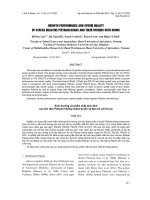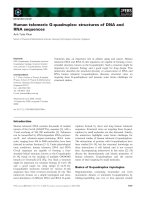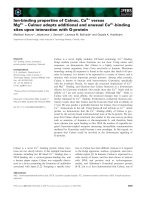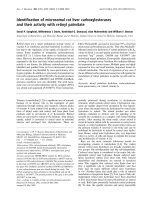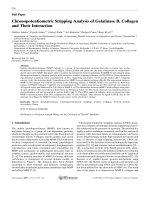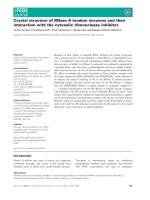Synthesis and structure investigation of stabilized aromatic oligoamides and their interaction with g quadruplex structures 7
Bạn đang xem bản rút gọn của tài liệu. Xem và tải ngay bản đầy đủ của tài liệu tại đây (948.56 KB, 14 trang )
195
Chapter 7
Colorimetric Screening of G-Quadruplex-Binding Ligands by
Aptamer-Modified Gold Nanoparticles
7.1 Introduction
Aptamers are short, single-stranded nuclic acid-based molecules that can
selectively recognize molecular targets (proteins, nucleic acids or small molecules)
with high affinities. They are selected from the pools of random sequences in vitro by
systematic evolution of ligands by exponential enrichment (SELEX).
1, 2
Because of
their chemically stability and excellent controllability, they have been extensively
applied in biological research,
3
clinical therapeutics,
4
sensing
5
and molecular
recognition.
6
Aptamers possessing G-quadruplex structural motifs have been developed as useful
biologics for binding or inhibiting specific proteins.
7
Recently, some G-quadruplex
aptamers have been proven to bind hemin to form a new class of DNAzyme with the
peroxidase-like activity.
8
An aptamer able to inhibit human Ribonuclease (RNase) H1
activity was also found to fold into a G-quadruplex.
9
In addition, numerous viral and
cellular proteins interact with quadruplex DNA in vivo.
10
One of the most known
aptamers capable of forming an intramolecular G-quadruplex motif is TBA (15-mer
Thrombin Binding Aptamer) which can be used as an inhibitor of blood
coagulation.
11-14
Thrombin is coagulation protein that plays many roles in the
196
coagulation cascade - it converts soluble fibrinogen into insoluble strands of fibrin,
and catalyze many other coagulation-related reactions. Therefore, thrombin is usually
considered as an important target when searching for anti-coagulants and
antithrombotics to interfere with the blood coagulation process. Consequently, TBA
has been widely studied due to their efficiency in recognizing thrombin and acting as
anticoauglants.
However, the overdosing of anticoagulants may cause adverse effects. To ensure
TBA with controllable anticoagulating performance, TBA-based
anticoagulant/antidote effector pairs have been studied.
15-18
Hartig et al has confirmed
the capability to antagonize the anticoagulant activity of TBA by cationic porphyrin
5,10,15,20‐tetra(N‐methyl‐4‐pyridyl)porphin (TmPyP4), a well-known
quadruplex-binding compound.
16
However, since then, few studies have been focused
on the development of novel TBA ligands, which could serve as antidote of the
anticoagulant.
Traditional methods such as circular dichroism (CD) and isothermal titration
calorimetry (ITC) were used to identify TBAs.
19
However, these techniques are both
time- and DNA-consuming. Recently, polymererase chain reaction (PCR) stop assay
was widely used because of its high sensitivity and specificity.
20
Nevertheless, most
existing PCR-based protocols require complicated equipments and are not suitable for
high-throughput screening. Therefore, a new screening system which could quickly
identify antidotes for anticoagulant needs to be developed.
Herein, we developed a new AuNPs screening assay to detect the effects of small
197
molecules on the interaction between thrombin and its aptamers. Furthermore, a new
class of macromolecules was synthesized and evaluated as the stabilizers of
G-quadruplex, which could also serve as antidote to TBA as evidence from our
AuNPs screening assay.
7.2 Result and Discussion
7.2.1 Design of Aptamer-Based AuNPs Screening Assay
AuNPs-based molecular recognition approaches are emerging as attractive
colorimetric probes due to their high sensitivity and selectivity.
5
Recently, a method
based on enzymatic manipulation of DNA on AuNPs was reported for screening
G-quadruplex ligands.
21
Our strategy for detecting antidote of TBA was illustrated in
Figure 7.1. Three key components are needed: gold nanoparticles (13nm diameter)
functionalized with 3’-thiol-modified TBA, thrombin, and ligands able to bind
G-quadruplex region of TBA. Gold-nanoparticles were induced to form aggregation
by adding thrombin into the solution due to the interaction between protein and its
aptamer. However, AuNPs aggregation could dissemble after the introduction of small
molecules into the above system. This is attributed to the interaction between ligands
and G-quadruplex aptamer could interfere with the binding of the aptamer toward
thrombin. In contrast, small molecules which are not G-quadruplex ligands will not
disaggregate AuNPs since the association between protein and TBA is not disrupted
by small molecules.
198
Figure 7.1. Illustration of AuNPs screening assay for identifying G-quadruplex ligands.
7.2.2 Application of aptamer-based AuNPs screening assay
O
N
H
O
HN
O
HN
O
NH
NH
O
OMe
OMe
MeO
MeO
OMe
1
O
N
H
O
HN
O
HN
O
NH
NH
O
OH
OMe
MeO
Me O
OMe
9a
O
N
H
O
HN
O
HN
O
NH
NH
O
OH
OMe
MeO
HO
OMe
10a
O
N
H
O
HN
O
HN
O
NH
NH
O
OH
OMe
HO
MeO
OH
11a
O
N
H
O
HN
O
HN
O
NH
NH
O
OH
OMe
Me O
HO
OH
10b
Scheme 7.1. Circular pentamers as potential G-quadruplex binders
A new category of macrocylic molecules with an aromatic oligoamide backbone
and different interior groups was synthesized in our lab (Scheme 7.1). According to
our previous study, those oligomides could serve as potential ligands for binding
199
G-quadruplex. In order to characterize their interaction with TBA, PCR stop assay
was first used. Based on the PAGE result, the double-stranded PCR product
disappeared when the concentration of 10a was higher than 1 μM, suggestive of the
binding interaction between 10a and TBA (Figure 7.2a).
a)
b)
Figure 7.2. Effect of 10a on the double-stranded PCR product synthesized from (a) TBA template, (b)
Control DNA which can not form G-quadruplexes structure. ds = double-stranded and ss =
single-stranded.
Next, the feasibility of AuNPs screening approach was tested against 10a. As
expected, by adding 10a into the system containing TBA-modified AuNPs (Au-TBA)
and thrombin, AuNPs aggregation was inhibited (Figure 7.3). This indicates that 10a
could disrupt the thrombin-TBA interaction. As in Figure 7.4, the shift of peak from
538 to 524 nm by the addition of 10a, which also indicates that 10a could hinder the
AuNPs aggregation. This result correlates well with PCR stop assay, suggesting 10a
could bind to TBA G-quadruplex region.
Lane
10a (μM)
12
3
4
5
8
421
0
ds
ss
Lane 1 2
3
45
842 1010a (μM)
ds
ss
200
Figure 7.3. Gold nanoparticles-based colorimetric detection of G-quadruplex-binding molecule: (a)
Au-TBA only, (b) Au-TBA in the presence of thrombin, (c) Au-TBA in the presence of thrombin and
10a (2 μM).
Figure 7.4. UV-vis spectra of Au-TBA with both thrombin and 10a and with thrombin only.
7.2.3 Sensitivity of Aptamer-Based AuNPs Screening Assay
To investigate the sensitivity of aptamer-based AuNPs assay, the minimum
concentration that could effectively inhibit AuNPs aggregation was studied. As in
Figure 7.5, even though the aggregation of gold nanoparticles remained when the
concentration of 10a is lower than 1 μM, at 0.75 μM, partial disaggregation of AuNPs
is evidenced. Coincidently, the lowest concentration that could inhibit the reaction of
DNA G-quadruplex polymerase in PCR stop assay was also 1 μM for 10a in the
previous study. This result indicates that the sensitivity of this AuNPs screening assay
300 400 500 600 700 800
0.2
0.3
0.4
0.5
0.6
0.7
Absorbance
Wavelength (nm)
abc
201
is as good as PCR stop assay.
Figure 7.5. Solution color change involving AuNPs in the presence of 10a at different concentrations:
(a) 0.25 μM, (b) 0.5 μM, (c) 0.75 μM, (d) 1 μM, (e) 2 μM.
7.2.4 Screening oligomers that binds TBA
To demonstrate its generality and utility, a series of different aromatic oligoamides
were studied using the aptamer-based AuNPs screening system (Figure 7.6 and Figure
7.7). Both the colorimetric assay and UV-via spectra suggest 10a, 11a and 10b could
serve as antidotes of TBA by binding TBA and so disrupting the protein-TBA
interaction. On the other hand, aggregation of gold nanoparticle still occurs in the
presence of either 1 or 9a, suggesting that either 1 or 9a display weak binding toward
TBA.
Figure 7.6. Colorimetric assay of Au-TBA with thrombin and different oligomers: Photographs of
interaction between thrombin and aptamer inhibiting by (a) 10a (b) 11a, (c) 10b, (d) 9a, (e) 1.
ab cd e
202
Figure 7.7. UV-vis spectrum of Au-TBA with both thrombin and different oligomers.
PCR stop assays were also performed for all the circular pentamers. As shown in
Figure 7.8, 10a, 11a, 10b showed the ability to inhibit double-stranded PCR product,
whereas double-stranded DNA could still be detected with the addition of 1 or 9a.
This PCR stop assay result correlates well with the colorimetric result of
AuNPs-based screening assay, indicating that only 10a, 11a, 10b could bind to TBA.
These results were in accordance with our previous study, showing that the presence
of more interior hydroxyl groups results in higher binding affinity of aromatic
oligoamides toward thrombin aptamer.
Figure 7.8. PCR stop assay for identifying TBA-binding molecules at 2
μM. In the absence of
pentagon-shaped molecules, PCR stop assay produced ds DNA product (lane 1); addition of pentamers
10a (lane 2), 11a (lane 3), and 10b (lane 4) completely suppressed the production of ds DNAs while
the production of ds DNAs was largely suppressed in the presence of pentamers 1 (lane 5) and 9a (lane
6); shows the position of ss DNA (lane 7).
ds
ss
1234
21 34567
300 400 500 600 700 800
0.05
0.10
0.15
0.20
0.25
0.30
0.35
0.40
0.45
0.50
0.55
0.60
0.65
0.70
0.75
Absorbance
Wavelength (nm)
10a
11a
11b
9a
1
203
Detailed PAGE studies for PCR stop assay were shown in Figure 7.9. For 10a, 11a,
10b, the detection limits were all about 1 μM.
a)
b)
Figure 7.9. Effect of 10b and 11a on the double-stranded PCR product synthesized from TBA
template.
As shown in Figure 7.10, when the concentrations of 10a, 11a, 10b were lower than
1 μM, double-stranded DNA PCR product could be detected by PAGE. This is
consistent with the phenomenon of colorimetric assay in Figure 7.5, which showed
the aggregation of gold nanoparticles when the concentration of 10a was lower than 1
μM.
Figure 7.10. Effect of 0.25 μM and 0.5 μM of 10a, 10b and 11a on the double-stranded PCR product
synthesized from TBA template.
Acylic oligomers were also tested by this AuNPs screening assay and were found to
Lane
11a (μM)
12
345
842
1
0
ds
ss
Lane
10b (μM)
12
345
8
421
0
ds
ss
Lane
Conc (μM)
13
46
0.5
0.25 0.5 0.25
Oligomer 10a 11a 11a 10b10a 10b
25
0.5 0.25
ds
ss
204
be unable to disintegrate the aggregated AuNPs (Figure 7.11 and Figure 7.12). This
result reinforces our previous finding, demonstrating that helically folded acylic
oligomers do not lead to the stabilization of G-quadruplex structure.
NO
2
N
O
H
O
O O
O
OC
8
H
17
(H
3
C)
2
HCO
N
H
O
O
NO
2
N
O
H
O
O O
O
OCH(CH
3
)
2
OC
8
H
17
N
H
O
O
N
N
O
H
O
O O
O
H
O
O
N
H
O
O
2
N
O
OCH(CH
3
)
2
2c
3f
5d
Scheme 7.2. Acyclic aromatic oligoamides
Figure 7.11. PCR stop assay illustrating the production of ds DNA product in the presence of no small
molecule (lane 1), 2c (lane 2), 3f (lane 3) and 5b (lane 4).
Figure 7.12. Colorimetric assay of acyclic oligomers showing (a) the disaggregation of AuNPs in the
absence of acyclic oligomers and the aggregation of AuNPs induced by (b) thrombin, (c) thrombin + 2c,
(d) thrombin + 3c, (e) thrombin + 5d.
7.2.4 Specificity of Aptamer-based AuNPs Screening Assay
To provide evidence that the inhibition of AuNPs aggregation in the designed
screening assay was caused by the interaction between the aptamer and small
molecules, lysozyme was chosen as the control protein. In the study carried out in
205
chapter 6, we observed that lysozyme could also induce the AuNPs aggregation due to
the nonspecific interactions between lysozyme and DNAs attached to the AuNPs.
With the addition of various pentamers into the solution containing DNA-modified
AuNPs and lysozyme, AuNPs aggregation was still observed (Figure 7.13). This
result indicates that those pentamers can not disrupt the nonspecific interactions
between lysozyme and DNAs. In contrast, binding between specific protein and its
aptamer such as TBA could be specifically disrupted by small molecule capable of
strong binding toward TBA. Thus, the developed AuNPs screening assay allows the
efficient and specific identification of G-quadruplex-binding ligands.
Figure 7.13. Aggregation states of Au-TBA in the presence of both lysozyme and pentamers: (a) 10a,
(b) 11a , (c) 10b, (d) 9a, and (e) 1.
Figure 7.14. UV-Vis spectra of Au-TBA containing 10a and lysozyme or 10a and thrombin.
7.2.5 Aromatic pentamers can also bind to the 29-mer thrombin aptamer
350 400 450 500 550 600 650 700 750 800
0.1
0.2
0.3
0.4
0.5
0.6
0.7
Absorbance
Wavelength (nm)
Lysozyme with 10a
Thrombin with 10a
206
The interaction between circular pentamers and 29-mer thrombin aptmer TBA2
were also studied using the developed AuNPs screening assay, which combines with
UV-vis spectra to demonstrate that 10a, 11a and 10b could effectively bind TBA2,
presumably through its G-quadruplex region akin to their binding toward TBA.
Figure 7.15. Visualizing the interactions between circular oligomers and TBA2: Au-TBA2 with (a)
thrombin only, (b) with both thrombin and 1, (c) with both thrombin and 9a, (d) with both
thrombin and 10b, (e) with both thrombin and 11a, (f) with thrombin and 10a.
7.3 Conclusion
In summary, aptamer-based AuNPs screening assay was proven to be an efficient
way to detect antidote of anticoagulant TBA. In addition, our new approach could
also be applied as a general method for identifying G-quadruplex-binding ligands,
such as aptamers of PDGF. AuNPs is better than PCR stop assays considering about
time (instant detection), expense (requiring no detection device) and detection
accuracy (slightly higher than PCR stop assay). .
7.4 Experiment Section
Performance of Taq Polymerase Stop Assay:
Thrombin aptamer and the corresponding complementary sequence
5'-TCTCTGTCACCAACCACA-3' were used. The chain-extension reaction was
207
performed in PCR buffer containing 0.2 mM dNTP, 2.5 U Taq polymerase, 7.5 pmol
oligonucleotides, 50 mM KCl or NaCl, and various concentrations of cyclic
pentamers. The mixtures were incubated in a thermocycler with the following cycling
conditions: 94
o
C for 30 s, 47
o
C for 30s and 72
o
C for 30 s. PCR products were
resolved on 20% native polyacrylamides gels in 1*TBE buffer and stained with Sybe
Gold. The intensity of Sybe Gold by measured and quantified.
Preparation of Aptamer-based AuNPs screening assay:
The 3’-terminal disulfide groups of the Thrombin binding apatamer strands were
first cleaved by soaking them in a 0.1 M dithiothreitol (DTT) phosphate buffer
solution (0.1 M phosphate, pH 8.0) for 2 hours and subsequently purified on a NAP-5
column (GE Healthcare). To 800 μL of gold colloid solution was added 3 nmol of the
purified oligonucleotide. The solution was brought to 0.3 M NaCl, 10 mM
NaH
2
PO
4
/Na
2
HPO
4
, pH 7.0 buffer (0.3 M PBS) gradually by adding aliquots of 3 M
NaCl and 0.1 M NaH
2
PO
4
/Na
2
HPO
4
, pH 7.0 buffer solutions every 12 hours. After 48
hours, the nanoparticle solutions were centrifuged and re-dispersed in 750 μL buffer
(0.3 M PBS). The final concentrations of the DNA on the probe were estimated to 0.3
μM.
208
Reference:
1. Ellingtion, A. D.; Szostak, J.W. Nature. 1990, 346, 818.
2. Tuerk, C.; Gold, L. Science. 1990, 249, 505.
3. Breaker, R. R. Nature. 2004, 432, 838.
4. Nimjee, S. M.; Rusconi, C. P.; Sullenger, B. A. Annu. Rev. Med. 2005, 56, 555.
5. Tai, C. C.; Huang C. C. Sensors. 2009, 9, 10356.
6. Hermann, T.; Patel, D. J. Science. 2000, 287, 820.
7. Huppert, J. L. Phil. Trans. R. Soc. A. 2007, 365, 2969.
8. Li, T.; Wang, E.; Dong, S. PLoS. ONE. 2009, 4,5126.
9. Pileur, F.; Andreola, M. L.; Dausse, E.; Michel, J.; Moreau, S.; Yamada, H.; Gaidamakov, S. A.;
Crouch, R. J.; Toulme, J. J.; Cazenave, C. Nucleic. Acid. Research. 2003, 31, 5776.
10. Fry, M. Front. Biosci. 2007, 12, 4336.
11. Bock, L. C.; Griffin, L. C.; Latham, J. A.; Vermaas, E. H.; Toole, J. J. Nature. 1992, 355, 564.
12. Kelly, J. A.; Feigon, J.; Yeates, T. O. J. Mol. Biol. 1996, 256, 417.
13. Macaya, R. F.; Schultze, P.; Smith, F. W.; Roe, J. A.; Feigon, J. Proc. Natl. Acad. Sci. USA. 1993,
90, 3745.
14. Kankia, B. I.; Marky, L. A. J. Am. Chem. Soc. 2001, 123, 10799.
15. Heckel, A.; Buff, M. C. R.; Raddatz, M. S. L.; Muller, J.; Potzsch, B.; Mayer, G. Angew. Chem.
2006, 118, 6900.
16. Joachimi, A.; Mayer, G.; Hartig, J. J. Am. Chem. Soc. 2007, 129, 3036.
17. Muller, J.; Wulffen, B.; Potzsch, B.; Mayer, G.
ChemBioChem. 2007, 8, 2223.
18. Wang, J.; Cao, Y.; Chen G. F.; Li, G. X. ChemBioChem. 2009, 10, 2171.
19. Haq, I.; Trent, J. O.; Chowdhry, B. Z.; Jenkins, T. C. J. Am. Chem. Soc. 1999, 121, 1768.
20. Lemarteleur, T.; Gomez, D.; Paterski, R.; Mandine, E.; Mailliet, P.; Riou, J F. Biochem.
Biophys. Res. Commun. 2004, 323, 802.
21. Chen, C.; Zhao, C.; Yang, X. J.; Ren, J. S.; Qu, X. G. Adv. Mater. 2010, 22, 389.
